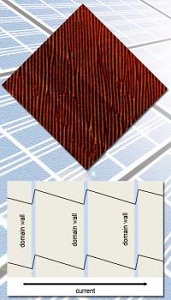LBL solar development shows promise for new PV cells
 Researchers at the Lawrence Berkeley National Laboratory (LBL) have developed a new type of photovoltaic cell using ferroelectric materials to boost the amount of voltage a solar cell can produce. While scientists have understood that ferroelectrics can have a photovoltaic reaction to light, this is the first time researchers have understood the process, which is likened to a bucket brigade.
Researchers at the Lawrence Berkeley National Laboratory (LBL) have developed a new type of photovoltaic cell using ferroelectric materials to boost the amount of voltage a solar cell can produce. While scientists have understood that ferroelectrics can have a photovoltaic reaction to light, this is the first time researchers have understood the process, which is likened to a bucket brigade.
“What we found, what’s special about bismuth iron-oxide [i.e., bismuth ferrite], grown in just the right way, is the electro-polarization can organize itself in a very useful way,” said Joel Ager who led the research. “In our analysis is why it is the charge moves in a useful direction.”
The devices were grown in SunShot Initiative Director Ramamoorthy Ramesh’s lab.
“It makes something like a sawtooth,” Ager said.
When exposed to light and photons are converted to electrons, they travel across a series of these saw-teeth, each with its own polarized domain. As they approach the edge of the sawtooth, they’re dumped at the bottom of a new domain and keep traveling across the device increasing the voltage.
“While a solar cell loses efficiency if electrons and holes immediately recombine, that can't happen here because of the strong fields at the domain walls created by the oppositely polarized charges of the domains,” LBL said in a press release.
A normal solar cell absorbs photons in electron holes on the surface and transmits the electricity through a p-n junction. It does so at low voltages, like .05 volts for silicon for instance.
The devices the team is working on demonstrated voltages of 15 volts but with no p-n junction.
“You get a very large voltage under illumination,” Ager said. “It makes the material like thousands of solar cells’ p-n junctions.”
Each of the oppositely oriented domains creates excess charge and passes it to the neighboring domain, according to LBL.
“The opposite charges on each side of the domain wall create an electric field that drives the charge carriers apart. On one side of the wall, electrons accumulate and holes are repelled. On the other side of the wall, holes accumulate and electrons are repelled,” LBL said.
While the team used bismuth ferrite to demonstrate the principle, it’s not the best material for a photovoltaic device, Ager said.
“One reason this is not the greatest solar cell is bismuth is not a great absorber of light. You need to get in to the ultraviolet [spectrum for it to work],” he said. “We are trying to make systems that are simple, to clearly show the generality of the effect and also make a prediction that it could work with other systems.”
Other systems or materials could be used to make a solar cell that can work under broader spectrums of light, making a viable solar cell with the technology possible.
Image courtesy of Lawrence Berkeley National Lab.



